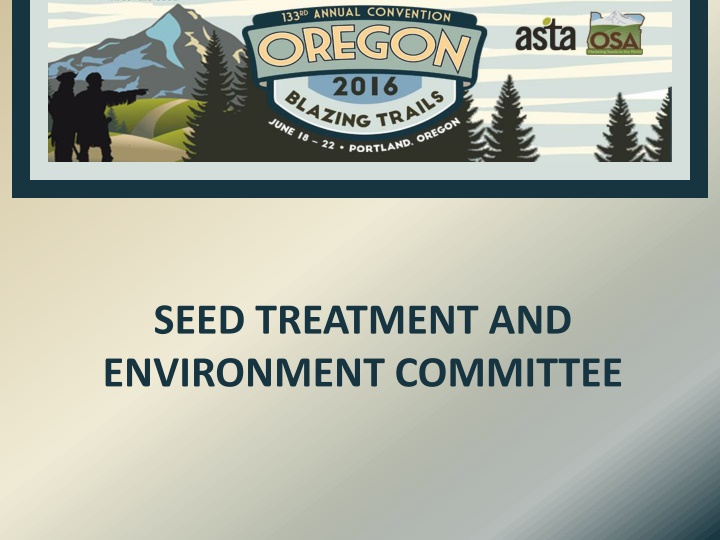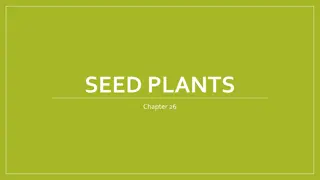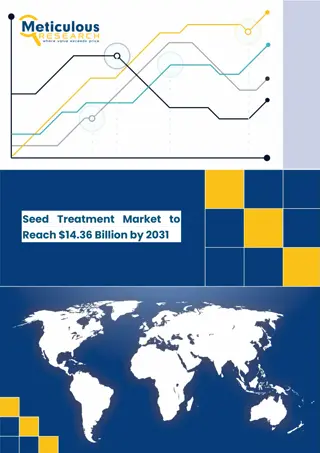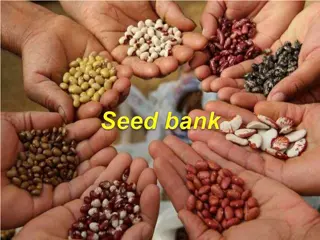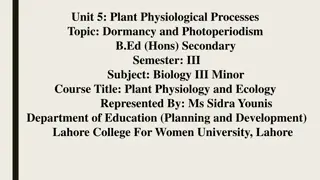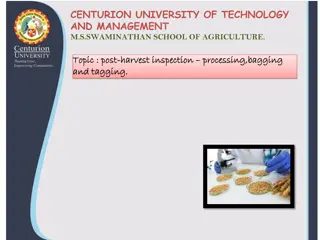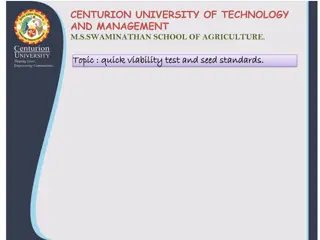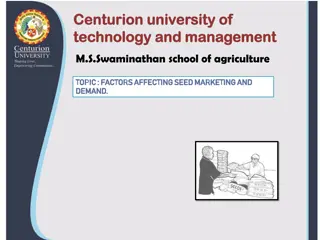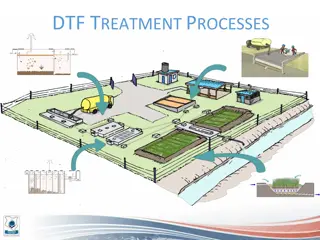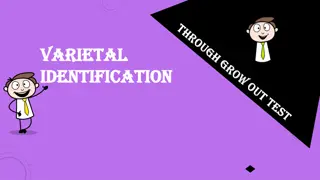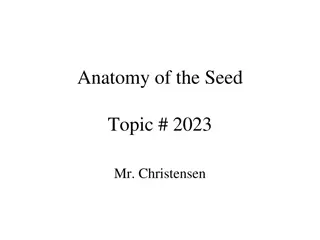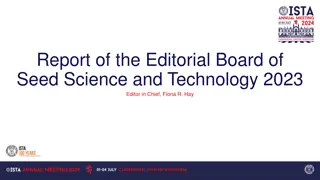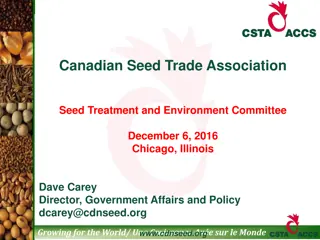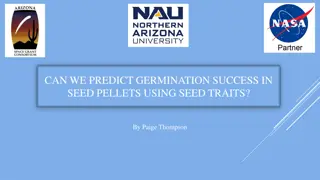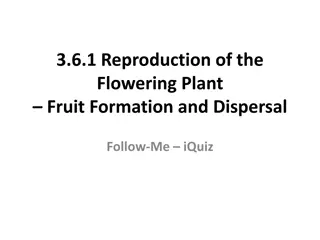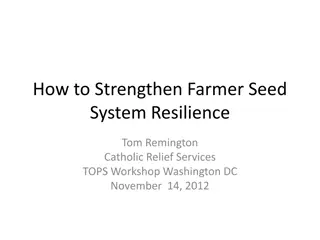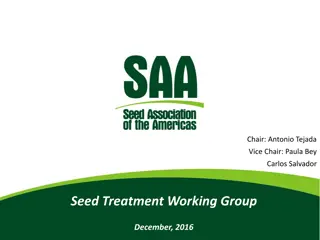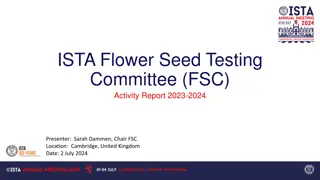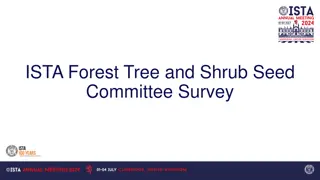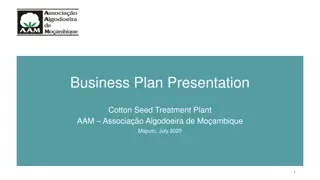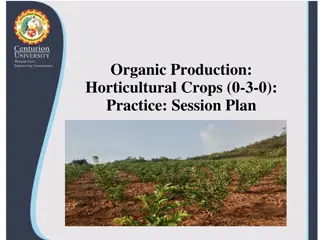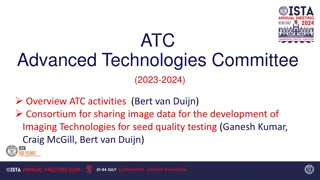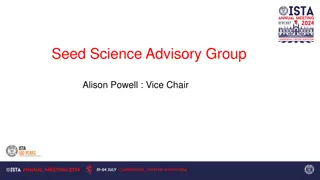Seed Treatment and Environment Committee
Updates and regulatory insights on seed treatment stewardship, biopesticides, and neonic reviews in the agricultural industry. Learn about upcoming guidance from EPA and initiatives for honeybee health and conservation programs for managed bees.
Download Presentation

Please find below an Image/Link to download the presentation.
The content on the website is provided AS IS for your information and personal use only. It may not be sold, licensed, or shared on other websites without obtaining consent from the author.If you encounter any issues during the download, it is possible that the publisher has removed the file from their server.
You are allowed to download the files provided on this website for personal or commercial use, subject to the condition that they are used lawfully. All files are the property of their respective owners.
The content on the website is provided AS IS for your information and personal use only. It may not be sold, licensed, or shared on other websites without obtaining consent from the author.
E N D
Presentation Transcript
SEED TREATMENT AND ENVIRONMENT COMMITTEE
ANDERSON VS. EPA/SEED TREATMENT LAWSUIT Kristin Landis, CropLife America Next steps
BIOLOGIC SEED TREATMENT WORKING GROUP UPDATE 23 Members Conference call February 16, 2016 Topics Covered Regulatory picture Allied coalitions Biopesticide Industry Association, Biostimulant Coalition Future discussions interest in focusing on state regulation of biostimulants
BIOLOGICAL SEED TREATMENT WORKING GROUP Complicated regulatory picture Federal and State oversight EPA State plant food control officials State pesticide regulators State seed control officials
NEXT STEPS EPA guidance coming out soon on their approach to biostimulants. May have public meeting or public comment. Align priorities among ASTA members and with industry coalitions. Discussion at Association of State Seed Control Officials summer meeting
GUIDE TO SEED TREATMENT STEWARDSHIP Plans for 2016-2017 Update website Revise materials General messages Draft Farmer messages What are the highest priority messages? Develop distribution plan GSTS Working Group to reconvene in July
HONEYBEE HEALTH COALITION Crop Pest Management MP3 plan development and implementation Forage and Nutrition Input to USDA Farm Service Agency for potential new conservation program for managed bees - CP42B
REGULATORY UPDATE U.S. Neonic review Chemical Name and Docket Number Planned Completion Milestones initial pollinator-only risk assessment issued for public comment in January 2016 potential early pollinator mitigation in 2016 remainder of risk assessments issued for public comment later in 2016 Imidacloprid EPA-HQ-OPP-2008-0844 2016-2017 initial set of risk assessments issued for public comment in 2016 potential early pollinator mitigation in 2016 remainder of risk assessments issued for public comment in 2017 Clothianidin EPA-HQ-OPP-2100-0865 2016-2017 initial set of risk assessments issued for public comment in 2016 potential early pollinator mitigation in 2016 remainder of risk assessments issued for public comment in 2017 Thiamethoxam EPA-HQ-OPP-2011-0581 2016-2017
REGULATORY UPDATE CANADA: FUNGICIDE REVIEW Thiram Proposal to cancel all uses ASTA comments May 27 Valuable tool Risk assessment over stated impact of seed treatment usage Iprodione (Rovral) Proposal to cancel all uses Used as seed treatment for carrot Comments due July 14 Captan Cancel seed treatment uses Comments due July 29
ASTA Treatment & Environment Committee Tuesday, June 21, 2016 State Regulation of Neonicotinoids Pat Miller ASTA Director, State Affairs
NOTE: States are currently in process of creating pollinator protection plans as mandated by USDA Through Farm Bureaus, Ag Departments, etc.
Legislation Search (all states, 2016 sessions) Bees - 356 bills Neonicotinoids 25 bills Pollinator 83 bills Monarchs 41 bills
Focus of Legislation Study / creation of a pollinator protection plan Ban neonics Awareness/resolutions Cooperative efforts between state agencies Designation of state insect Special license plates/months/etc. Recognition of community projects Save the milkweed programs
Legislation Passed CA AB 559 Monarch butterflies: conservation Fish and Game Code: awareness/partnership CT SB 231 Establishment of best practices (Citizen s Guide) Limitations on application Highway ROW pollinator planting preference Creation of a Pollinator Advisory Committee Impact report mandate General pollinator management
Legislation Passed MD HB 211 / SB 198 (was much worse when filed) Restrictions on sales and use of neonics License to apply required (farmers exempt) Creation of a pollinator protection plan Government pollinator risk assessment
Legislation Passed VT H 861 Initially, the bill would have allowed the state to regulate treated articles (i.e. utility poles, commercial crop seeds, and lumber) The state s agriculture agency currently regulates pesticide and herbicide use with the exception of treated articles. The bill, as passed, establishes a committee to study the impact of the pesticides on bee populations
Regulatory Action MN Pollinator Law The supervisor of the Nursery Inspection Unit of the Plant Protection Unit stated that Seed is covered under the Pollinator Statute as plant material. So seed advertised as pollinator friendly or beneficial to bees, insects, birds etc would be subject to possible sampling and testing (for pesticides) Thus, if labeled as pollinator friendly then it must not have levels of systemic insecticides that cause greater than the no observed adverse effect in pollinators However, the state seed control official intervened and conveyed that nursery didn t have jurisdiction
